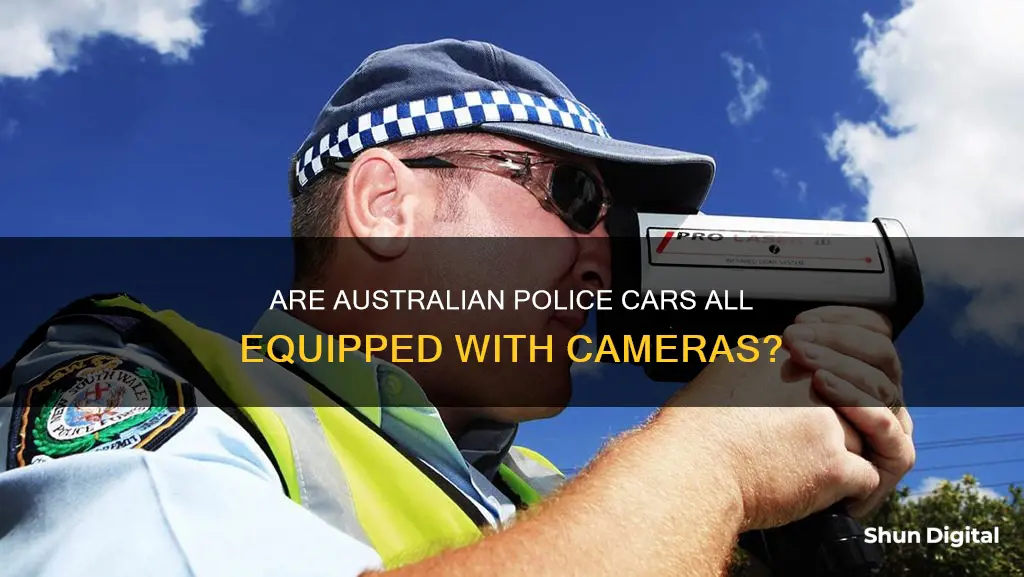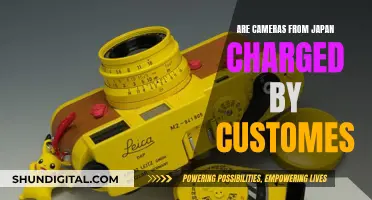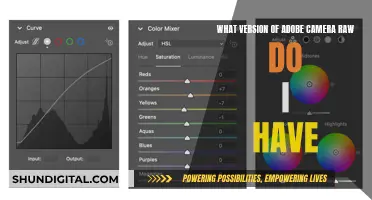
In Australia, police cars are equipped with various technologies to assist in law enforcement and road safety. While it is unclear if all police cars have cameras, it is known that police vehicles in New South Wales (NSW) are fitted with Automatic Number Plate Recognition (ANPR) technology, dashcams, and lidar. This technology enables the scanning of license plates, the recording of audio and video, and the detection of speeding. Additionally, police in NSW and Queensland have started using new vehicles, such as the BMW 530d, Chrysler 300 SRT, and Kia Stinger, for highway patrol duties.
| Characteristics | Values |
|---|---|
| Camera type | Dashcam, bodycam, automatic number plate recognition (ANPR) |
| Purpose | To record incidents or interactions with the public, capture evidence at incident scenes, and detect unregistered vehicles |
| Usage | Police must activate their cameras to capture an incident or interaction with the public or when exercising a police power |
| Data access | Only authorised officers will have access to the footage. All access to footage is monitored, tracked, and auditable. |
| Data storage | Non-evidentiary footage will be retained for 90 days, while other footage is held for periods determined by legislation |
| Data disclosure | Police must give a copy of the recording within seven days when a person has been arrested for an indictable offence or when someone has been given their caution and rights, along with any admissions made |
| Data editing | Police can edit or redact footage when preparing evidence for a court hearing, if necessary or required by law |
What You'll Learn

Police cars in New South Wales (NSW) have Automatic Number Plate Recognition (ANPR) technology
The ANPR system in NSW police cars works through three or four 360-degree cameras mounted on the car's roof. These cameras are linked to a computer that runs optical recognition software. The system can detect unregistered, stolen, or suspect vehicles by sounding an alarm when it finds a match in its database. This technology is used to help take unlicensed drivers off the road and prevent crashes.
The data from the ANPR system is linked to a laptop computer and a mobile data terminal fitted in each police vehicle, allowing for easy access to information. The system also includes a live CCTV camera fitted to the roof of some patrol vehicles, providing a real-time feed to the traffic management centre.
The ANPR technology is a valuable tool for police investigators, as it allows them to add entries for specific vehicles to show up in real time by requesting a sighting report. This capability enhances the efficiency of police operations by allowing them to focus their resources on suspect vehicles.
The ANPR database also includes details of motor vehicles registered to convicted drivers' addresses, preventing them from using cars registered to other occupants at the same address. This feature ensures that officers in the field can identify and stop these drivers.
The NSW Police Force has been utilising mobile ANPR technology since 2009, and it continues to be an essential tool for law enforcement in the state.
Lightroom CC and Camera Raw: Preset Compatibility
You may want to see also

Queensland police cars have adopted the V6 Kia Stinger
Queensland Police Service (QPS) has adopted the V6 Kia Stinger as its primary enforcement vehicle, making it the first law enforcement agency in the world to do so. The Stinger replaces the now-discontinued Holden Commodore and Ford Falcon, which were once the mainstays of Australian police fleets.
The decision to use the Stinger was not taken lightly, with QPS evaluating vehicles from various manufacturers, including the Volkswagen Passat, BMW 5 Series, Mercedes E-Class, and Volvo S60. The rigorous testing procedure considered criteria such as performance, safety, and cost-effectiveness. The Stinger impressed with its 3.3-litre twin-turbo V6 engine, producing 272kW of power and 510Nm of torque, enabling it to sprint from 0 to 100km/h in just 4.9 seconds. Its rear-wheel-drive configuration also inspired confidence in police officers, providing smooth and efficient intercept capabilities.
As of 2024, QPS has deployed a total of 54 Stingers, with 43 marked and 11 unmarked units. These vehicles are equipped with automatic number plate recognition technology (ANPR), enabling officers to scan and identify unregistered vehicles, wanted offenders, and stolen cars. The Stingers also feature a standard police fit-out, including additional wiring for police radios and lighting.
The adoption of the Kia Stinger by QPS has been well-received by the public, with positive feedback and curiosity surrounding the new patrol cars. The choice of the Stinger is a significant milestone for the Kia brand, showcasing its vehicles' capabilities and performance.
While Queensland has opted for the Stinger, other Australian states like NSW have chosen different vehicles for similar roles, such as the BMW 5 Series. As Australian car manufacturing comes to an end, police fleets are evolving, and the Stinger has proven to be a capable and worthy successor to the iconic Commodore and Falcon.
Are Camera Speeding Tickets Worth Contesting in Court?
You may want to see also

Victoria Police use Body Worn Cameras (BWC)
Victoria Police introduced Body-Worn Cameras (BWC) in 2018 in response to a recommendation from the 2016 Royal Commission into Family Violence. The BWCs are small, battery-powered cameras worn on the torso of frontline police officers while on patrol. They constantly record but only save footage when manually activated by the officer. The cameras capture audio and video recordings of interactions between officers and the public, including real-time footage of incident scenes.
BWC footage is defined as 'Protected Information' under the Surveillance Devices Act 1999, and only authorised officers can access it. All access to footage is monitored, tracked, and auditable, and the original footage is always retained and unaltered. The availability of footage is dependent on the type of offence committed and whether the offender has been given their caution. The footage can be used as evidence in court and for investigative purposes.
Victoria Police does not have a way to consistently track all police officers' use of BWCs and does not know how compliant they are with activation requirements. An audit by the Victorian Auditor-General's Office found that in March 2021, Victoria Police officers activated their BWCs in 83.6% of the instances they were required to, leaving 16.4% of interactions unrecorded. This may result in weaker evidence for investigations and a reduction in transparency in complaint investigations.
To address this, Victoria Police has developed a dashboard that shows summarised statistics on how police officers are using their BWCs and managing footage. However, this dashboard does not help measure the force's overall compliance with activation requirements. The audit made several recommendations to improve compliance monitoring and tracking of intended benefits, including implementing a compliance monitoring tool and establishing guidance for using the dashboard.
Yi Home Camera: Does It Have a Battery?
You may want to see also

NSW police cars have dashcams and lidar
NSW police cars are fitted with a range of advanced technology to assist officers in their daily duties and ensure road safety. One of the key features of these vehicles is the in-car video recording system, or dashcam, which captures both audio and video footage during high-speed pursuits and when interacting with individuals of interest. This system is integrated into the rear-view mirror of the car and automatically starts recording when the warning lights are activated, providing valuable evidence that can be used in court if needed.
In addition to the dashcams, NSW police cars are also equipped with speed-checking devices, including LIDAR (Light Detection and Ranging) and RADAR technology. These devices can be configured in mobile mode when officers are on the move or stationary mode, allowing them to obtain the speeds of approaching vehicles from long distances. The LIDAR system uses laser speed testing to detect speeding vehicles, while RADAR technology helps monitor multiple lanes and capture images of vehicles exceeding the speed limit.
The Automatic Number Plate Recognition (ANPR) system is another crucial component of NSW police cars. This system uses high-tech number plate readers, introduced in 2013, that can scan up to six licence plates per second. The cameras mounted on the car's roof are linked to a computer running optical recognition software and a database of stolen, unregistered, or suspect vehicles, triggering an alarm when a match is found. This technology has been a valuable tool for detecting unregistered vehicles and locating wanted offenders and stolen cars.
The combination of dashcams, LIDAR, and ANPR technology in NSW police cars enhances the capabilities of law enforcement officers, providing them with tools to effectively monitor road safety, gather evidence, and improve the overall safety of the community.
Fight Camera Tickets in Arizona: Your Legal Options
You may want to see also

NSW police cars have in-car video cameras
In-car video cameras are standard in NSW police cars. These cameras are part of an extensive video recording system that films what's happening outside the vehicle's front and rear windows. The system is integrated into an aftermarket rear-view mirror installed in each car.
The cameras are always rolling, providing continuous footage that can be used as evidence in court if required. Senior Constable Amy Di Ramio of the NSW highway patrol division explains:
> "When I see an offence, I usually hit record on the audio and video, I narrate the offence that I've seen and when it's safe to do so I activate the warning lights and the sirens and then go from there. As soon as you hit the lights, the video system begins recording. It is on a continuous loop and backtracks 30 seconds from when first activated."
The in-car video cameras ensure that every road user infringement is documented. This helps to reduce road trauma and improve road safety in NSW.
The NSW Police Force is also adopting new technologies to enhance their capabilities. For example, they have recently introduced Automatic Number Plate Recognition (ANPR) technology, which can scan up to six licence plates per second. This technology is being rolled out across the state as part of a $7 million investment, demonstrating the force's commitment to utilising the latest advancements to improve their effectiveness.
Fight Traffic Camera Tickets: Florida Drivers' Guide
You may want to see also
Frequently asked questions
No, but Automatic Number Plate Recognition (ANPR) technology is being rolled out across the country. This technology includes cameras that scan number plates at a rate of six per second.
Police car cameras are used to detect unregistered vehicles, wanted offenders, and stolen vehicles. They can also be used to document road-user infringements and the footage can be used as evidence in court.
Australian police cars may be equipped with dashcams, body-worn cameras, and Automatic Number Plate Recognition cameras.







